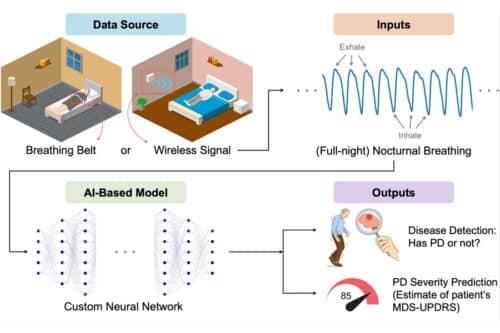MIT researchers have developed an AI module that can detect Parkinson’s disease with breathing patterns of the patient.

Image Credits: MIT Researchers
The classical method of detecting Parkinson’s using cerebrospinal fluid requires specialized medical centers and incurs huge cost. To overcome this, a team of researchers from MIT has developed a new AI model that looks like a Wi-Fi router. This device can detect Parkinson’s disease through the breathing patterns. The tool is a neural network with a series of algorithms similar to the function of a human brain. This neural network can assess the person from their nocturnal breathing and track the progression of the illness over time.
The team demonstrated that the assessment can be done every night when the patient is sleeping without touching their body. The router-like device emits radio signals, analyzes the reflections, and extracts the patient’s breathing patterns without any physical contact. The breathing signal is then fed to the neural network for further assessment. This reduces the chance of motor symptoms due to stress in the subject and the need for a nurse.
The new AI model device can be installed in the patient’s room at ease. It also monitors the progress of the disease apart from simple diagnosis. It is also expected that this device might detect other neurological disorders in the near future.
“A relationship between Parkinson’s and breathing was noted as early as 1817, in the work of Dr. James Parkinson. This motivated us to consider the potential of detecting the disease from one’s breathing without looking at movements,” Dina Katabi, the Thuan and Nicole Pham Professor in the Department of Electrical Engineering and Computer Science at MIT says. “Some medical studies have shown that respiratory symptoms manifest years before motor symptoms, meaning that breathing attributes could be promising for risk assessment prior to Parkinson’s diagnosis.”






